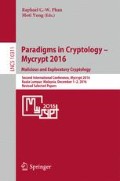Abstract
Digital watermarking embeds unremovable information called a “mark” into digital objects such as images, video, audio files, and program data without changing their functionalities. This article provides a brief overview of recent advances in watermarking for cryptographic programs and insights behind them.
Access this chapter
Tax calculation will be finalised at checkout
Purchases are for personal use only
Notes
- 1.
We introduce the name by Barak et al. [2] as it is.
- 2.
Or non-adaptive chosen circuit attacks (CCA1).
- 3.
This notation is used in many papers. In particular, we borrow from the work of Lin and Vaikuntanathan [13].
- 4.
Otherwise Chernoff bound does not work.
- 5.
Such pPRFs are constructed from DDH or LWE assumptions [6].
References
Barak, B., Goldreich, O., Impagliazzo, R., Rudich, S., Sahai, A., Vadhan, S., Yang, K.: On the (im)possibility of obfuscating programs. In: Kilian, J. (ed.) CRYPTO 2001. LNCS, vol. 2139, pp. 1–18. Springer, Heidelberg (2001). doi:10.1007/3-540-44647-8_1
Barak, B., Goldreich, O., Impagliazzo, R., Rudich, S., Sahai, A., Vadhan, S.P., Yang, K.: On the (im)possibility of obfuscating programs. J. ACM 59(2), 6 (2012)
Boneh, D., Lewi, K., Wu, D.J.: Constraining pseudorandom functions privately. Cryptology ePrint Archive, Report 2015/1167 (2015). http://eprint.iacr.org/2015/1167
Boneh, D., Waters, B.: Constrained pseudorandom functions and their applications. In: Sako, K., Sarkar, P. (eds.) ASIACRYPT 2013. LNCS, vol. 8270, pp. 280–300. Springer, Heidelberg (2013). doi:10.1007/978-3-642-42045-0_15
Boyle, E., Goldwasser, S., Ivan, I.: Functional signatures and pseudorandom functions. In: Krawczyk, H. (ed.) PKC 2014. LNCS, vol. 8383, pp. 501–519. Springer, Heidelberg (2014). doi:10.1007/978-3-642-54631-0_29
Cohen, A., Holmgren, J., Nishimaki, R., Vaikuntanathan, V., Wichs, D.: Watermarking cryptographic capabilities. In: Wichs, D., Mansour, Y. (eds.) 48th ACM STOC, pp. 1115–1127. ACM Press, New York (2016)
Galbraith, S.D., Verheul, E.R.: An analysis of the vector decomposition problem. In: Cramer, R. (ed.) PKC 2008. LNCS, vol. 4939, pp. 308–327. Springer, Heidelberg (2008). doi:10.1007/978-3-540-78440-1_18
Garg, S., Gentry, C., Halevi, S., Raykova, M., Sahai, A., Waters, B.: Candidate indistinguishability obfuscation and functional encryption for all circuits. In: 54th FOCS, pp. 40–49. IEEE Computer Society Press, October 2013
Goldreich, O., Goldwasser, S., Micali, S.: How to construct random functions. J. ACM 33(4), 792–807 (1986)
Hopper, N., Molnar, D., Wagner, D.: From weak to strong watermarking. In: Vadhan, S.P. (ed.) TCC 2007. LNCS, vol. 4392, pp. 362–382. Springer, Heidelberg (2007). doi:10.1007/978-3-540-70936-7_20
Kiayias, A., Papadopoulos, S., Triandopoulos, N., Zacharias, T.: Delegatable pseudorandom functions and applications. In: Sadeghi, A.-R., Gligor, V.D., Yung, M. (eds.) ACM CCS 2013, pp. 669–684. ACM Press, New York (2013)
Lewko, A.: Tools for simulating features of composite order bilinear groups in the prime order setting. In: Pointcheval, D., Johansson, T. (eds.) EUROCRYPT 2012. LNCS, vol. 7237, pp. 318–335. Springer, Heidelberg (2012). doi:10.1007/978-3-642-29011-4_20
Lin, H., Vaikuntanathan, V.: Indistinguishability obfuscation from DDH-like assumptions on constant-degree graded encodings. In: Dinur, I. (ed.) 57th FOCS, pp. 11–20. IEEE Computer Society Press, Washington, D.C. (2016)
Nishimaki, R.: How to watermark cryptographic functions. In: Johansson, T., Nguyen, P.Q. (eds.) EUROCRYPT 2013. LNCS, vol. 7881, pp. 111–125. Springer, Heidelberg (2013). doi:10.1007/978-3-642-38348-9_7
Okamoto, T., Takashima, K.: Homomorphic encryption and signatures from vector decomposition. In: Galbraith, S.D., Paterson, K.G. (eds.) Pairing 2008. LNCS, vol. 5209, pp. 57–74. Springer, Heidelberg (2008). doi:10.1007/978-3-540-85538-5_4
Okamoto, T., Takashima, K.: Fully secure functional encryption with general relations from the decisional linear assumption. In: Rabin, T. (ed.) CRYPTO 2010. LNCS, vol. 6223, pp. 191–208. Springer, Heidelberg (2010). doi:10.1007/978-3-642-14623-7_11
Sahai, A., Waters, B.: How to use indistinguishability obfuscation: deniable encryption, and more. In: Shmoys, D.B. (ed.) 46th ACM STOC, pp. 475–484. ACM Press, New York (2014)
Waters, B.: Dual system encryption: realizing fully secure IBE and HIBE under simple assumptions. In: Halevi, S. (ed.) CRYPTO 2009. LNCS, vol. 5677, pp. 619–636. Springer, Heidelberg (2009). doi:10.1007/978-3-642-03356-8_36
Yoshida, M., Fujiwara, T.: Toward digital watermarking for cryptographic data. IEICE Trans. 94-A(1), 270–272 (2011)
Yoshida, M., Mitsunari, S., Fujiwara, T.: The vector decomposition problem. IEICE Trans. 93-A(1), 188–193 (2010)
Acknowledgments
The author would like to thank Pooya Farshim for invaluable and constructive comments.
Author information
Authors and Affiliations
Corresponding author
Editor information
Editors and Affiliations
Rights and permissions
Copyright information
© 2017 Springer International Publishing AG
About this paper
Cite this paper
Nishimaki, R. (2017). Watermarking Cryptographic Programs. In: Phan, RW., Yung, M. (eds) Paradigms in Cryptology – Mycrypt 2016. Malicious and Exploratory Cryptology. Mycrypt 2016. Lecture Notes in Computer Science(), vol 10311. Springer, Cham. https://doi.org/10.1007/978-3-319-61273-7_28
Download citation
DOI: https://doi.org/10.1007/978-3-319-61273-7_28
Published:
Publisher Name: Springer, Cham
Print ISBN: 978-3-319-61272-0
Online ISBN: 978-3-319-61273-7
eBook Packages: Computer ScienceComputer Science (R0)

